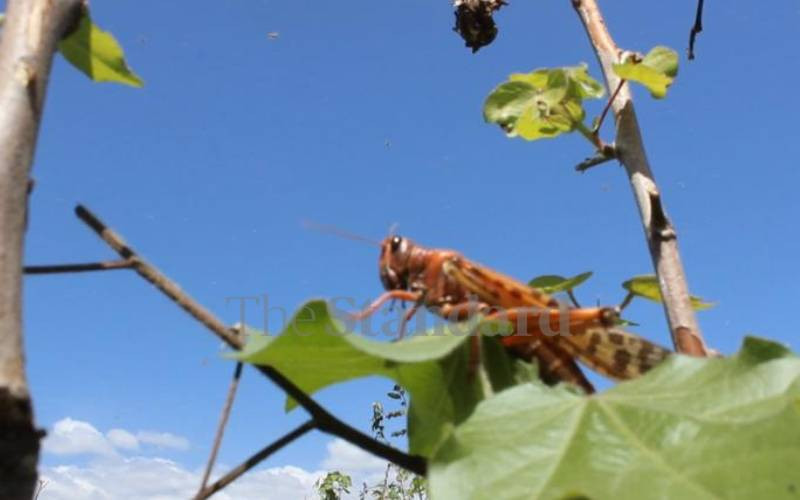An ignored international early warning system, fear of Al Shabaab attack and late intervention compounded the locust invasion in Isiolo, Meru and Samburu, the Saturday Standard has learnt.
Ethiopia and Djibouti in June last year informed Nairobi to take early preparation to counter the locust invasion through the National Drought Management Authority (NDMA) but this crucial warning was ignored by relevant government agencies, including the Ministry of Agriculture and Livestock Development’s Plant Protection Unit (PPU).
The Addis-Ababa based Food and Agriculture’s (FAO) Desert Locust Control Organisation (DLCO) had warned that rontier counties of Mandera, Wajir, Marsabit and Garissa should be on red alert for the invasion.
Djibouti was soon invaded by swarm of locusts whose origin was traced by DLCO to southern Yemen and it spread to the Ogaden region of Ethiopia and western Somalia.
The Horn of Africa Nations had received similar early warning albeit three months earlier as it would have taken longer for the deadly insects to reach Kenya.
‘‘We (NDMA), received the alert from Ethiopia and Djibouti and we relayed the same information to all relevant government agencies six months before the locust invasion,’’ a source said.
Another NDMA official added; ‘‘The early warnings from Addis Ababa and Djibouti were ignored and senior government officials in the Ministry of Agriculture (Livestock and Fisheries) slept on their jobs’’.
Mandera was the first to be hit by the invasion through Takaba Sub-county and in days, the locusts had reached Wajir West in late December.
George Ongamo, coordinator of the local Desert Locust Management team, said the invasion was on last December 22 but first reported on December 28.
The locust later spread to Marsabit’s Saku and Moyale sub-counties. They reached Saku’s Shuur and Jaldesa locations from the direction of Wajir West while in Moyale the insects came through two routes - Takaba in Mandera and Bute; Gurar and Buna in Wajir North.
Garissa was the fourth county to be hit after the locusts flew in through Habaswein, Abakore and different areas in Wajir South.
As the government delayed in countering the menace, residents of Mandera and Wajir resorted to unorthodox ways to fight the armies of insects whose invasion was mainly traced to Somalia.
The methods employed included shouting, blowing whistles and hooting of vehicles, in a bid to scare away the pests. Divine intervention was also sought through special prayers and long recitation of the Quran, while the police who provide security to guard against attack by Al Shabaab militia, were spotted firing shots in the air to scare away the locusts.
Spraying of the locusts by a helicopter started in Mandera more than 10 days after the pests were reported, meaning the locusts had ample time to spread to Wajir. In Wajir, the spraying started on January 7, according to Agriculture and Livestock Development Chief Officer Noor Mohammed.
Hassan Gure, an official in the Department of Agriculture and Livestock in Wajir said the first phase of aerial spraying started in Wajir South, adding the delay in intervention had allowed the spread of the locusts to neighbouring counties.
Stay informed. Subscribe to our newsletter
Wajir Deputy Governor Ahmed Mukhtar said the administration was working with various inter-governmental and DLCO to contain the menace.
Northern Kenya leaders led by National Assembly Majority Leader Aden Duale (Garissa Township) his counterparts Adan Keynan (Eldas), Ali Wario (Bura), Ali Rasso (Saku) Qalicha Gufu (Moyale) and Hassan Odha (Isiolo) decried the late intervention, adding the government ought to have declared the invasion a national disaster.
 The Standard Group Plc is a
multi-media organization with investments in media platforms spanning newspaper
print operations, television, radio broadcasting, digital and online services. The
Standard Group is recognized as a leading multi-media house in Kenya with a key
influence in matters of national and international interest.
The Standard Group Plc is a
multi-media organization with investments in media platforms spanning newspaper
print operations, television, radio broadcasting, digital and online services. The
Standard Group is recognized as a leading multi-media house in Kenya with a key
influence in matters of national and international interest.
 The Standard Group Plc is a
multi-media organization with investments in media platforms spanning newspaper
print operations, television, radio broadcasting, digital and online services. The
Standard Group is recognized as a leading multi-media house in Kenya with a key
influence in matters of national and international interest.
The Standard Group Plc is a
multi-media organization with investments in media platforms spanning newspaper
print operations, television, radio broadcasting, digital and online services. The
Standard Group is recognized as a leading multi-media house in Kenya with a key
influence in matters of national and international interest.






